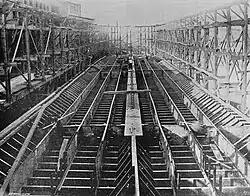Channel system (shipbuilding)

The channel system is a method of ship construction where several rows of large, flanged steel plates run longitudinally within a ship's hull. The style derived its name from the "channels" between the frames. Invented by Sinclair Stuart, a surveyor for the United States Standard Registry of Shipping, it was introduced to the Great Lakes in the mid–1890s, becoming a standard feature of vessels built there thereafter.[1]
This practice dispensed with the common tradition of frames composed primarily of angle iron. It lent a vessel much greater strength, prevented possible damage sustained in a grounding from spreading to other areas of a hull, and increased the cargo capacity, without expending a greater quantity of materials than the previous design.[2]
References
- ^ "The Marine Review: Volume 11, Number 18 – May 2, 1895". Cleveland, Ohio: The Marine Review. 1895. Within the "Channel System of Hull Construction" section on page 6. Retrieved 10 August 2025 – via maritimehistoryofthegreatlakes.ca.
- ^ "The Marine Review: Volume 12, Number 11 – September 12, 1895". Cleveland, Ohio: The Marine Review. 1895. Within the "From Lake and Coast Builders" section on pages 20, 21, and 22 respectively. Retrieved 10 August 2025 – via maritimehistoryofthegreatlakes.ca.